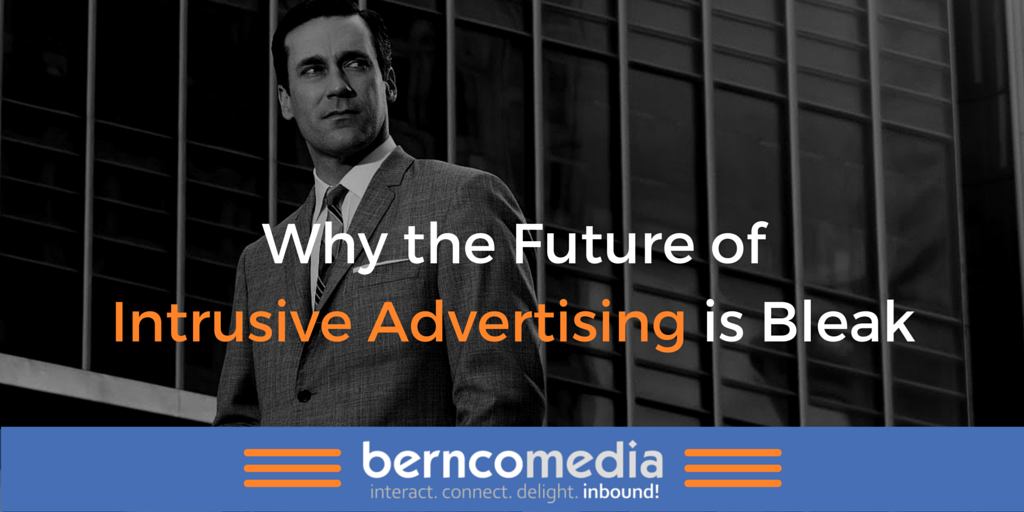Why the Future of Intrusive Advertising is Bleak
April 5th, 2016
4 min read

Allow Me To Interrupt Your Life For This Stupid Advertisement
Do you record your favorite television shows so you can fast-forward through the commercials?
Have you ever channel-surfed through radio stations in the car, so you don't have to subject yourself to cheerful but obnoxious commercials or jingles?
Yup, this is the world we live in now. I know it's the world I live in. My DVR saves me not only the pain of watching some new stupid big pharma commercial, but it saves my time. I can bust out an hour-long TV show in 43 minutes flat!
But enough about my addiction to TV.
As advertising reaches critical mass both online and off, consumers continually seek ways to avoid it. That's why ad blockers have become so ubiquitous among Internet users. Why view ads when a free or less annoying alternative exists?
However, this doesn't mean advertising is dead. It honestly means that businesses need to recognize the death knell of intrusive advertising when they hear it.
First, the Numbers

Understanding ad blocking's impact in black and white can help you find non-intrusive solutions.
Page Fair and Adobe joined forces in 2015 to analyze the ad-blocking situation and its consequences for publishers, businesses, and digital advertising agencies. According to the resulting report, ad-blocking cost publishers more than $20 billion in 2015, and nearly 200 million people use ad-blocking software worldwide.
The statistics make the situation sound dismal, but ad blocking doesn't have to mean the end of advertising. In fact, it's merely a symptom of our changing culture. People want to choose how they encounter businesses on the web and offline, which means businesses have to find ways to get consumers' attention without annoying them.
That's a positive thing. If you irritate your target market, consumers within that market won't want to buy from you. However, if you can get their attention through non-intrusive means, you increase your chances of developing long-term, profitable relationships with your customers.
Understanding How the Numbers Impact Your Bottom Line

If you ask your prospects for permission, they'll feel respected and appreciated.
 As it turns out, it's truly better to ask permission first than to beg forgiveness later, no matter what the latest action movie hero might suggest. Permission marketing -- a term popularized by marketing genius Seth Godin -- facilitates honest, open communication between businesses and their target markets. It's also the root benefit of an inbound marketing strategy.
As it turns out, it's truly better to ask permission first than to beg forgiveness later, no matter what the latest action movie hero might suggest. Permission marketing -- a term popularized by marketing genius Seth Godin -- facilitates honest, open communication between businesses and their target markets. It's also the root benefit of an inbound marketing strategy.
Imagine for a moment that you're walking into a retail store. A sales associate greets you warmly and asks if you need any assistance. You say no, you're just browsing, and she wanders away to allow you to shop in peace. When you find something you want, you call her over to ask questions and to complete the transaction. You walk away satisfied and impressed.
Now tweak the scenario a bit. You tell the salesperson you don't need help, but she stays glued to your side. She points out products you don't want or need and asks intrusive questions about your lifestyle, habits, and preferences. Chances are, you'll excuse yourself and walk away without making a purchase, and you may even leave with a negative opinion of the company.
That's the difference between intrusive and permission marketing. Instead of losing customers by irritating them, you're attracting them by respecting their boundaries.
Attracting New Customers Through Content Creation
Think of website content as a magnet. It pulls target customers to your site and hooks them with interesting facts, engaging anecdotes, or answers a common question they may have about your product or service.
This only works, however, if you create the type of content that your target market needs. Buyer personas, market research, and search engine optimization can help you achieve your goals without annoying the people you hope to serve.
According to Seth Godin, permission marketing operates on the engagement factor. If you disappear from your prospects' radar, they'll come looking for you because they value the content you provide. Maybe your marketing manager gets sick, and the blog goes silent for a week. You get inundated with emails from avid readers who want to know why the latest post was dated seven days ago.
Essentially, you're using content to foster a culture in which people come to you, which means you don't have to go to them. Instead of interrupting, disrupting, or annoying your customers, you're inviting them to join you.
Approaching Advertising From a Permission Standpoint
Ad blockers might restrict your options regarding digital advertising, but it doesn't eliminate them entirely. Native advertising is one of the most compelling hot-button topics in the industry today and for good reason.
Native advertising combines the best of both worlds: advertising and content marketing. Instead of displaying a flashy, disruptive animated advertisement on a website, you create a compelling piece of content with an embedded advertising message. The consumer derives actual value from the content, so it's not an intrusive strategy, but you still get the opportunity to tout the benefits and features of your product or service.
You have myriad options for native advertising exposure, such as:
- Social media: Promoted or featured posts on social media can link to native advertising pieces.
- Upscale publishers: From Forbes and Newsweek to niche publications, major publishers often accept paid advertising pieces that resemble news or how-to content.
- Recommendations: You might see them at the bottom of blog posts and articles. Each advertisement is contained in a box that directs the user to your content.
As you can see, ad-blocking software and consumers' aversion toward advertisements don't have to restrict your options. If you embrace strategies like content marketing and native advertising, you can instill trust and loyalty in your audience while still gaining brand exposure.
Setting the Standard
Plenty of businesses still embrace old-school marketing and advertising strategies. They create empty, meaningless content that they hope will attract both customers and search engines. They employ outbound marketing tactics, spending thousands or even millions of dollars on radio spots and TV commercials. They even create those blinking-flashing-blinding display ads that make customers close their browsers.
If you follow these same methodologies just because it seems to be the industry standard, you'll miss out on a rare opportunity. If you embrace non-intrusive advertising first, you can set the standard in your industry and remain forever ahead of the curve.
Inbound marketing offers a wide variety of strategies that don't depend on intrusive advertising approaches.
If you're looking for a better way to market your business online, schedule a free inbound marketing assessment. We'll help you identify ways to bring your marketing strategy in line with customer expectations.
Until next time,
Doc
Owner/Head Coach @ Bernco Media. Digital sales & marketing since 1997. Passion for teaching companies to be the most trusted voice in their space. They Ask, You Answer Certified Coach & HubSpot Certified Partner & Trainer. Reversed Type 2 Diabetes doing KETO. Wears Mickey Mouse Daily. Daydreaming of next Disneyland Trip.
Topics:
